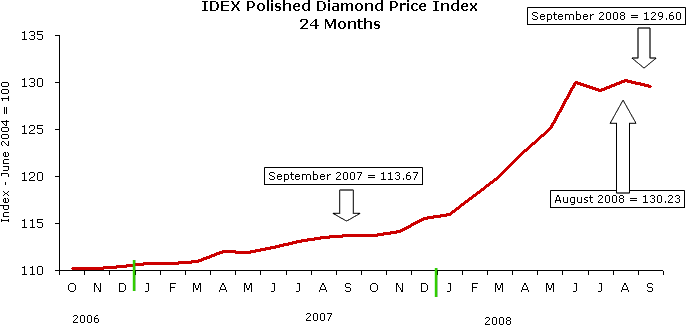IDEX Online Research: Polished Diamond Prices Soften Slightly in September
October 02, 08
The global polished diamond markets were a relative oasis of calm and tranquility amid a roiling sea of turmoil in the world’s financial markets during September. Global stock and commodities prices rose and fell like a yo-yo, but diamond prices remained relatively stable, with only a slight downward drift during the month.
During September, polished diamond prices were down 0.5 percent (one-half of one percent) from the average polished prices during August 2008, according to the IDEX Online Global Polished Diamond Price Index. On a year-over-year basis, average prices for polished diamonds were 14.0 percent higher in September 2008 versus the same month a year ago. The year-over-year diamond price increase represents a modest deceleration which has been occurring for the past few months.
What kept the diamond trading markets insulated and stabilized from the tumultuous activity in the other commodity and stock markets? It is still a closed market, where traders remain relatively calm, even under the most adverse circumstances. Diamond traders are different from other commodities traders: they have a personal attachment to their product, often a result of family heritage. They understand the market and the product. They have a sense of responsibility to maintain an orderly market, even if demand and supply are out of balance.
But, we hasten to note, the orderly diamond trading markets won’t always be insulated from the foibles of the global financial markets, especially if diamonds and diamond funds begin trading on those financial markets. In our opinion, diamond prices would have been whipsawed up and down during the month, just like other commodities and stocks, if they had been traded on global financial markets.
While polished diamond prices appear to have held more or less stable, September was a challenging month for polished diamond dealers. Trading activity slowed, especially among stones in the three-to-five carat range. Dealers did not want to drop their prices for these larger stones, as reflected by continued high “asked” prices on the IDEX Online Polished Diamond trading platform. However, rather than take lower prices, most dealers chose to hold onto their larger, better quality stones; they anticipate that in a year or so, prices will firm up.
The big question on everyone’s mind is this: what happens next?
- In terms of diamond demand, the simplistic answer is this: diamond and jewelry demand correlate closely with economic cycles. If the global economy slows, diamond demand in the world’s major markets – the U.S., Japan and Europe – will soften, perhaps significantly. Diamond demand in other developing markets – the Middle East, India and China – won’t be as affected. For example, even if oil prices remain low for a protracted period, there is enough cash in the Middle East to support diamond demand for a long time. In India and China, the market is growing fast enough to offset any major impact from economic cycles.
- In terms of diamond prices, many dealers are wondering if they could tumble, similar to many of the world’s equity markets. We don’t know the answer to that. But we can calculate diamond prices, using historic inflation levels for polished diamonds; we can also calculate diamond prices based on global equity indices.
- In terms of the 14 percent or so price increase in polished diamonds in 2008, this inflation rate is far above the historic annual inflation rate of 4 percent or so for polished diamonds. Assuming a “normal” polished diamond price inflation rate, the IDEX Online Polished Diamond Price Index would be around 119.5 at the end of September, rather than 129.6, as reported. Simplistically, polished diamond prices would be about 10 percent lower than they are today.
- If polished diamond prices had followed the world’s equity markets, the IDEX Online Polished Diamond Price Index would be about 87, down roughly 25 percent for the year from January 2008 levels. Polished diamond prices would be down by about one-third from current levels. In other words, a diamond priced at $10,000 per carat in January 2008 would be worth only about $6,700 today, if diamond prices had followed global equity prices so far this year. The good news: this is a highly unlikely scenario.
The best advice: sit tight, don’t panic (like the traders in the financial markets), and wait for this economic cycle to stabilize. Remember, the tide comes in, and the tide goes out. And it always comes back in.
Two-Year Diamond Price Acceleration Slows in September
The graph below summarizes the IDEX Online Polished Diamond Price Index for the past 24 months. This graph represents the composite average prices of all diamonds traded at the wholesale level. The slope of the line steepened in the first half of the year, reflecting consistently higher prices – and a greater rate of price inflation – for virtually all diamond sizes. However, since June, polished diamond price inflation has paused, as the red line illustrates.
|
|
 |
The graph below summarizes month-to-month changes in global diamond prices for the past thirteen months. Since January 2008, polished diamond prices showed large gains during every month in the first half of the year.
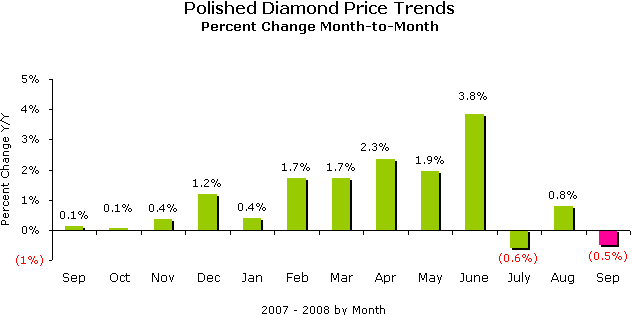
Source: IDEX Online Research
September 2008 versus September 2007: +14.0 percent
On a year-over-year basis, global polished diamond prices were 14.0 percent higher in September 2008 versus the same month a year ago – September 2007. While this was a near-record gain, it represents a deceleration of year-over-year price increases for polished diamonds. Further, it is beyond the high end of the overall long term price inflation rate in the polished diamond industry. On a year-over-year basis, prices of diamonds below three carats in size showed more moderate inflation levels, while prices for diamonds three carats and larger reflected higher price inflation rates which characterized the market for many months earlier this year. We think that diamond prices would decline more, if diamond traders were to shirk their responsibility to maintain an orderly market. 
Even though September’s year-over-year inflation rate continued to show moderation, it is unreasonable to believe that this annualized level of diamond price inflation – +14 percent – is sustainable, even though rough diamond prices have risen by about 16 percent or so this year. However, most other commodities have risen sharply in price over the past several years. As we have said many times, the polished diamond industry remains too fragmented for anyone – or any group – to hold pricing power similar to the tight-knit community of rough diamond suppliers. The IDEX Online Polished Diamond Price Index stood at 129.60 in September 2008 versus 113.67 in September a year ago.
The graph below summarizes the year-over-year inflation rate by month for polished diamond prices in the global market for the past thirteen months.
Comparisons are based on the daily average prices during the month versus the same month a year ago (e.g. September 2008 versus September 2007). The year-to-year comparison takes into account the seasonality of polished diamond demand and prices.
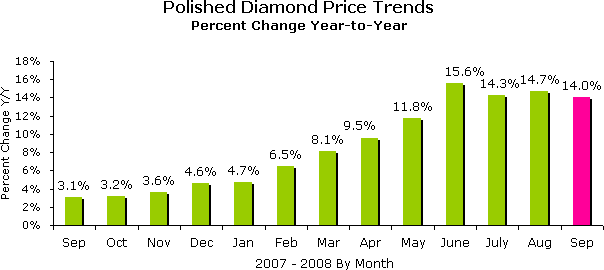 Source: IDEX Online Research |
Daily Polished Prices Drifted Slightly Lower During the Month
Polished diamond prices drifted slightly lower in September, after an accelerating increase for the first half of 2008, followed by stabilization in June, July and August. This coincides with the slide of global financial markets as investors and merchants became more worried about the possibility of a worldwide recession extending perhaps into 2009. Diamond traders found that they were unable to buy and sell diamonds at the artificially high prices reflected on some industry price lists; thus, overall asking prices declined slightly to more realistic levels. Still, there was no panic similar to that which characterized the global financial markets.
The following graph illustrates the average price of polished diamonds on a day-by-day basis for the three-month period July-September 2008. While there was some modest polished diamond price volatility early in the month of September, prices stabilized – softening slightly – during the second half of the month. Since the end of the month, prices have continued to soften modestly into October.
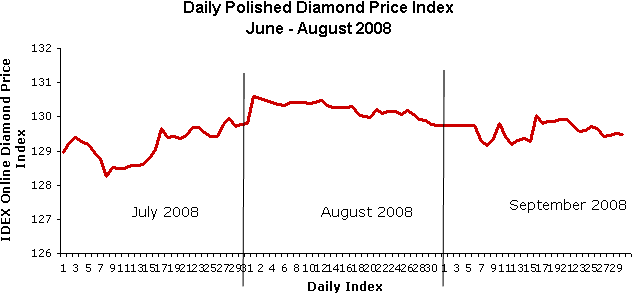
Source: IDEX Online Research
Month-to-Month Diamond Prices Virtually Unchanged for All Sizes
It appears that polished diamond prices have stabilized, at least for the short term, with almost all sizes posted only slight price deflation. While demand had been strong for large diamonds – in the 4-5 carat range – retailers are now seeing some shopper reticence as consumers buy “down.” Rather than the largest, fanciest stone, shoppers are willing to compromise on either quality or size. Shoppers are opting for more modest, though flashy stones, according to retail merchants’ reports.
The graph below summarizes the price changes for key sizes of polished diamonds on a month-over-month basis: September 2008 versus August 2008. These seven stone sizes represent about 33 percent of the trading market by value.
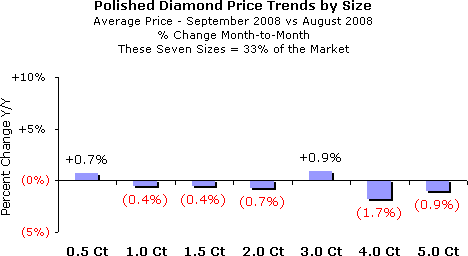 Source: IDEX Online Research |
Year-Over-Year Diamond Prices for All Sizes Continue to Show Decelerating Double-Digit Price Inflation
On a year-to-year comparison, polished diamond prices continued to rise at double-digit levels for all but the smallest stones one-half carat and below. As has been the trend for this diamond demand cycle (about 3-4 years), prices for large stones in the three-to-five carat range showed a much higher inflation rate than prices for stones two-carat and smaller stones. However, it is important to note that the year-over-year price inflation rate for polished diamonds is decelerating.
The graph below summarizes polished diamond prices by key sizes on a year-over-year basis: September 2008 versus September 2007. These seven sizes represent about one-third of the market, by aggregate value.
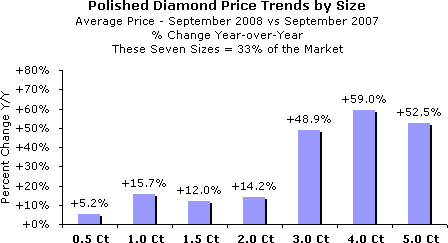
Source: IDEX Online Research
Long Term Diamond Price Inflation Concentrated in Large Stones
Based on the IDEX Online Polished Diamond Price Index, polished diamond demand for stones three carats and higher has been much greater over the long term than demand for smaller stones in the range of one-half carat up to three carats in size.
The graph below summarizes the long term price inflation – for the past four years – for the seven key diamond sizes, based on the IDEX Online Polished Diamond Price Index. This is not the annual inflation rate. Rather, this graph reflects the total polished diamond price increase for the seven sizes listed. For example, one-half carat diamond prices have barely risen over the past four years. On the other hand, three-carat diamond prices have doubled (+110.5 percent), while four-carat diamond prices have tripled (+206.6 percent). These gemstones are round, colors D to K, and clarities IF to SI3.
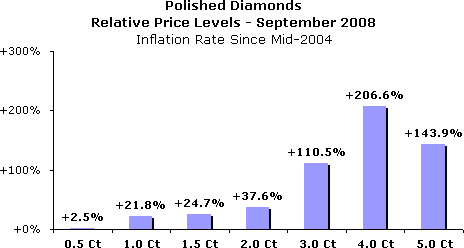
Source: IDEX Online Research
Month-End Polished Diamond Prices Still Relatively Strong
The graph below summarizes the prices for diamonds of the seven key sizes that account for about one-third of the total diamond trading market volume. These stones are round, colors D to K, and clarities IF to SI3.
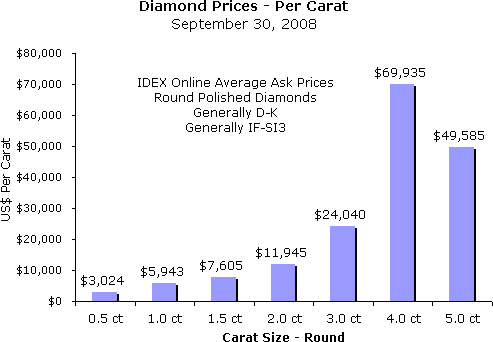
Source: IDEX Online Research
Forecast: Polished Diamond Prices Will Pause for the Foreseeable Future
The flames of polished diamond price inflation which characterized the market earlier this year have been snuffed out, in our opinion. While polished diamond prices rose at unrealistic rates in the first half of the year, we do not foresee this trend in the second half of 2008. There is too much uncertainty related to the global economic situation to fuel continued diamond price inflation at the unusually high rates earlier this year.
Interestingly, economic growth as measured by Gross Domestic Product (GDP) remains relatively robust – or at least stable – for most of the world’s economies. For example, in the U.S., second quarter economic growth was +3.3 percent, just slightly below the average since 1934 of +3.4 percent. But the media is whipping consumers and businesses into a frightened frenzy. For sure, consumers are in a mental recession which could translate into a real recession later this year.
Further, central banks worldwide are pumping money into their economies; this should keep credit markets liquid and help stimulate growth.
Wall Street has continued its yo-yo action. In part, trading specialists have abdicated their responsibilities to maintain an orderly trading market; in part, Wall Street is roaring at the U.S. Congress, calling for a bail-out . . . or else!
Oil prices have retreated, so consumers’ pocketbooks won’t be so pinched as we head into the holiday selling season. This could help maintain demand for discretionary goods. Consumer confidence has recovered slightly, but it is not an indicator of retail sales, as some people claim. Still, if people feel better, it will help stabilize these turbulent times.
The IDEX Online Diamond Price Index
The IDEX Online Diamond Price Index is a real-time index derived from actual asking prices in the global diamond industry. The IDEX Online Diamond Price Index objectively reflects price trends as they happen. The Diamond Index and Diamond Drivers were formulated following comprehensive research and analysis of the IDEX Online inventory database, aggregated since 2001. Research and development were conducted in cooperation with Dr. Avi Wohl, Senior Lecturer of Finance at the faculty of Management, Tel Aviv University, Israel.
Additional information is available from IDEX Online Research. The e-mail address is diamondprices@idexonline.com.
